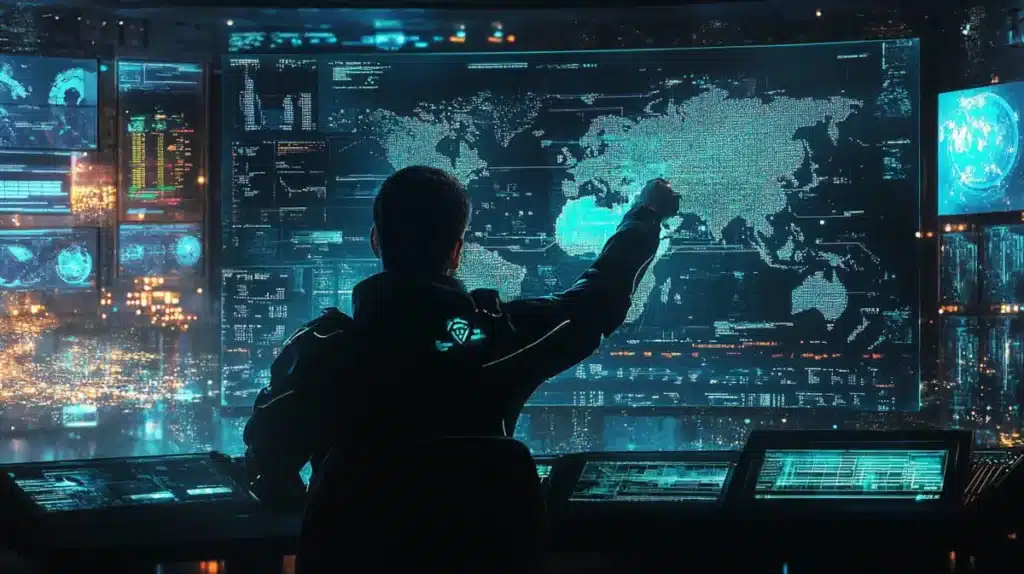Cyberwarfare has become a modern form of conflict, where battles no longer take place solely on physical battlefields but within networks and computer systems.
Cyberwarfare is characterized by the use of digital attacks carried out by states or hacker groups to disrupt, spy on, or destroy critical adversary infrastructures. These attacks, often invisible and silent, can wreak havoc in key sectors such as power grids, control systems, or even nuclear programs.
Many states, including the United States, the United Kingdom, and countries like North Korea and Iran, are heavily investing in digital warfare technologies.
What is cyberwarfare?
Cyberwarfare refers to the use of digital tools and computing technologies to execute attacks against the systems, networks, and infrastructures of another state or organization. Unlike traditional armed conflicts, digital wars are fought in cyberspace, a virtual domain where actors can inflict real damage on critical infrastructures such as power grids, financial systems, or a country’s nuclear programs.
Cyberwarfare vs cybercrime vs cyberespionage
| Criterion | Cyberwarfare | Cyberespionage | Cybercrime |
|---|---|---|---|
 Definition and Objectives |
Digital conflicts conducted by states or groups to destabilize critical infrastructures and create political, economic, or military disruption. | Gathering of sensitive or secret information without disrupting systems to obtain confidential data. | Illegal activities aimed at financial gain or causing disruptions. |
 Main Actors |
Nation-states, military, hacker groups backed by governments. | Nation-states, intelligence agencies, private companies. | Individuals or criminal groups, independent hackers. |
 Impact |
Political destabilization, infrastructure sabotage, economic or military paralysis. | Leakage of sensitive information that could affect national security or a company’s competitiveness. | Financial losses, identity theft, data destruction or corruption. |
 Legality / Consequences |
Considered an act of war, often provoking military or diplomatic retaliation. | Illegal under international laws, often sanctioned diplomatically or economically. | Illegal, often punished by criminal prosecutions (fines, imprisonment). |
 Execution |
Planned and sophisticated attacks, often involving state actors with considerable resources. | Stealthy and prolonged infiltration, requiring discretion to avoid detection. | Conducted by cybercriminals using varied methods, from simple to complex. |
Examples of cyberwarfare
One of the most notable cases is the 2010 attack against the Iranian nuclear facilities using a computer worm known as Stuxnet. This malicious software, allegedly created by the United States in collaboration with Israel, caused significant damage to Iran’s centrifuges, significantly delaying its nuclear program.
Another noteworthy example is the attack against Sony Pictures in 2014, orchestrated by North Korea in response to the movie “The Interview,” an act that led to the massive leak of sensitive data.
In 2007, Estonia suffered a series of distributed denial-of-service (DDoS) attacks that paralyzed government, banking, and media systems for several weeks. This attack is widely attributed to Russian actors, in response to a controversy over the relocation of a Soviet monument in Tallinn.
The importance of media
The media plays a central role in cyberwarfare operations by becoming fertile ground for the dissemination of information and misinformation on a large scale. Platforms like Facebook, X (formerly Twitter), and Instagram become powerful tools for influencing public opinions, manipulating political events, and destabilizing governments. By spreading fake news or conspiracy theories, malicious actors can create confusion and sow discord in a target population, which has become a potent weapon in modern conflicts.
A striking example of this use of social media is how hacker groups, such as the notorious collective Anonymous, have organized cyberwarfare operations and DDoS attacks against governments or companies, using these platforms to coordinate their actions. Similarly, nation-states use social networks to conduct disinformation campaigns, as Russia did during the 2016 US presidential election, influencing voters through targeted messages and automated bots.

Prevention and protection against cyberwarfare
Governments and companies worldwide are doubling their efforts to protect their computer systems and critical infrastructures. Cybersecurity has become a strategic priority, with massive investments in implementing sophisticated defense systems.
States are bolstering their cyber defense centers and forming specialized teams capable of quickly detecting and responding to threats. Simultaneously, companies, especially in sensitive sectors like energy or finance, are adopting enhanced security protocols to protect their networks.
With the increasing threats such as malware and DDoS attacks, secure data management becomes essential to minimize disruption risks. Technologies like data encryption, intrusion detection systems, and advanced firewalls are widely adopted to limit the impact of potential attacks.
Conclusion
Cyberwarfare is redefining modern conflicts. Faced with this growing threat, international cooperation and strengthening cybersecurity are essential to protect nations and ensure international and geopolitical stability.











